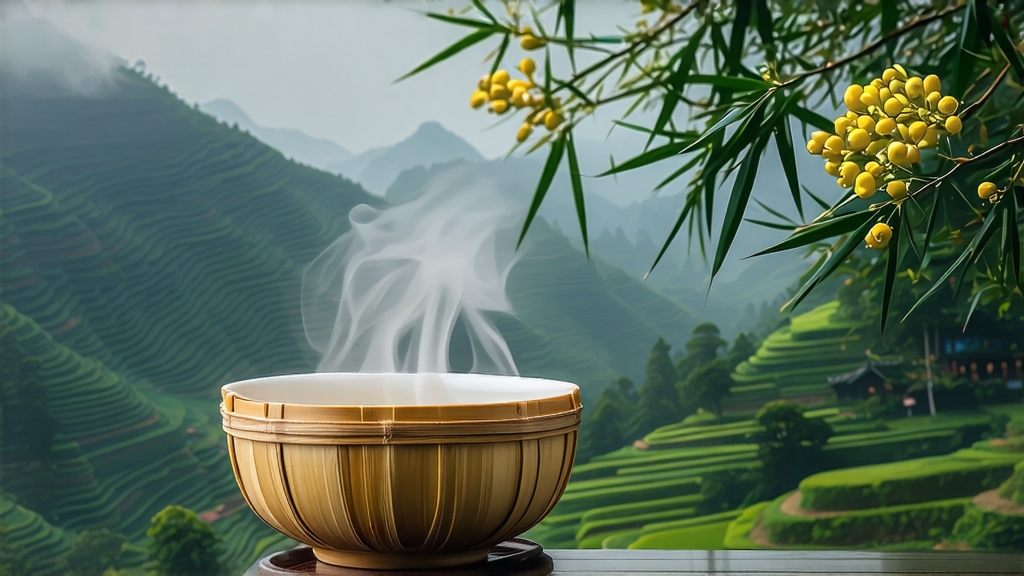
Meng Ding Huang Ya, literally “Yellow Bud from Meng Summit,” is the least-traveled celebrity of China’s six great tea families. While green tea’s jade freshness and pu-erh’s earthy mystique have marched across borders, this yellow-gold curiosity has spent thirteen centuries content to remain folded into the fog of Mt. Meng, a spur of the Tibetan Plateau that pushes its granite shoulder into Sichuan’s Ya’an prefecture. International drinkers may never have heard its name, yet emperors once waited half a year for a few ounces; court pharmacologists listed it ahead of ginseng in the Tang Bencao; and Song-dynasty poets compared its liquor to “the first moonlight on thawing snow.” Today the same mountain, 1,450 m above sea level, still produces fewer than 15 tons a year—less than a single morning’s output from a modern green-tea factory. The result is a tea that carries the bright DNA of green tea but wears the mellow cloak of micro-fermentation, a flavor paradox best summed up by local pluckers: “three days green, three days yellow, three days locked in bamboo.”
History: From Daoist Altar to Imperial Tribute
Mt. Meng has been a sanctuary of Daoist alchemists since the Han dynasty. Legend claims that Wu Lizhen, a hermit of the Western Han, planted seven tea bushes on the summit in 53 BCE as an offering to the mountain’s dragon spirit. By the Tang dynasty those bushes—still alive today, crowned as “immortal mother trees”—were yielding buds so pale they looked gilt, and so delicate that monks guarded them with scarecrows wearing tiny bronze bells. In 724 CE Emperor Xuanzong decreed Meng Ding tea a tribute item, and a courier road was carved through cloud forest so that frozen bamboo tubes of fresh buds could reach Chang’an in seven days. The Song court raised its status to “Number One under Heaven,” and Ming scholars coined the term huang cha (yellow tea) to distinguish the slow-yellowed buds from ordinary green. After the fall of the Qing the road fell into disrepair; the tea vanished from northern markets and survived only as a whispered secret among Sichuan caravans. Rediscovery came in 1959 when a provincial research team retraced the courier route, found ancient withering huts, and persuaded three hereditary families to resume production. In 2008 Meng Ding Huang Ya was granted China’s GI (Geographical Indication) protection, locking its pedigree to a mere 13 villages on the southern face of the mountain.
Terroir: Where Clouds Polish the Leaf
The microclimate is a marriage of Tibetan cold and Sichuan humidity. Winter frost lingers until Qingming; spring dawns at 8 °C and climb only to 18 °C by noon. Cloud cover filters 35 % of sunlight, forcing the tea bush to manufacture extra theanine and fewer catechins, the chemical basis for the tea’s signature sweetness. Soil is a crumbly granite latosol, pH 4.7, laced with quartz that reflects morning heat back onto the low bushes. Cultivars are seed-selected descendants of the original hermit trees—small-leaf, slow-growing, and so frost-hardy that pickers work in padded jackets when the rest of Sichuan is already in T-shirts. The altitude keeps pests dormant, so the gardens remain spray-free; instead, farmers hang small pots of fermented soy sauce to attract lacewings that devour aphids.
Plucking: One Bud, One Leaf, Before the Mountain Bell
The harvest window opens ten days before Qingming and closes when the first thunderstorm arrives—usually less than three weeks. Standard is “one bud, one leaf, half-open,” meaning the second leaf must still be folded like a paper fan. Experienced pluckers pinch and twist in a single motion so the tender stem breaks without bruising; nails are forbidden. Daily quota is barely 500 g fresh weight, enough for 100 g finished tea, and every kilogram contains roughly 12,000 tips. Leaves descend the mountain in bamboo sieves lined with banana leaf, a practice that keeps them cool and prevents the “red edge” that would disqualify yellow processing.
Craft: The Lost Art of Men Huang (Smothering)
Yellow tea’s soul lies in men huang, a controlled re-hydration that